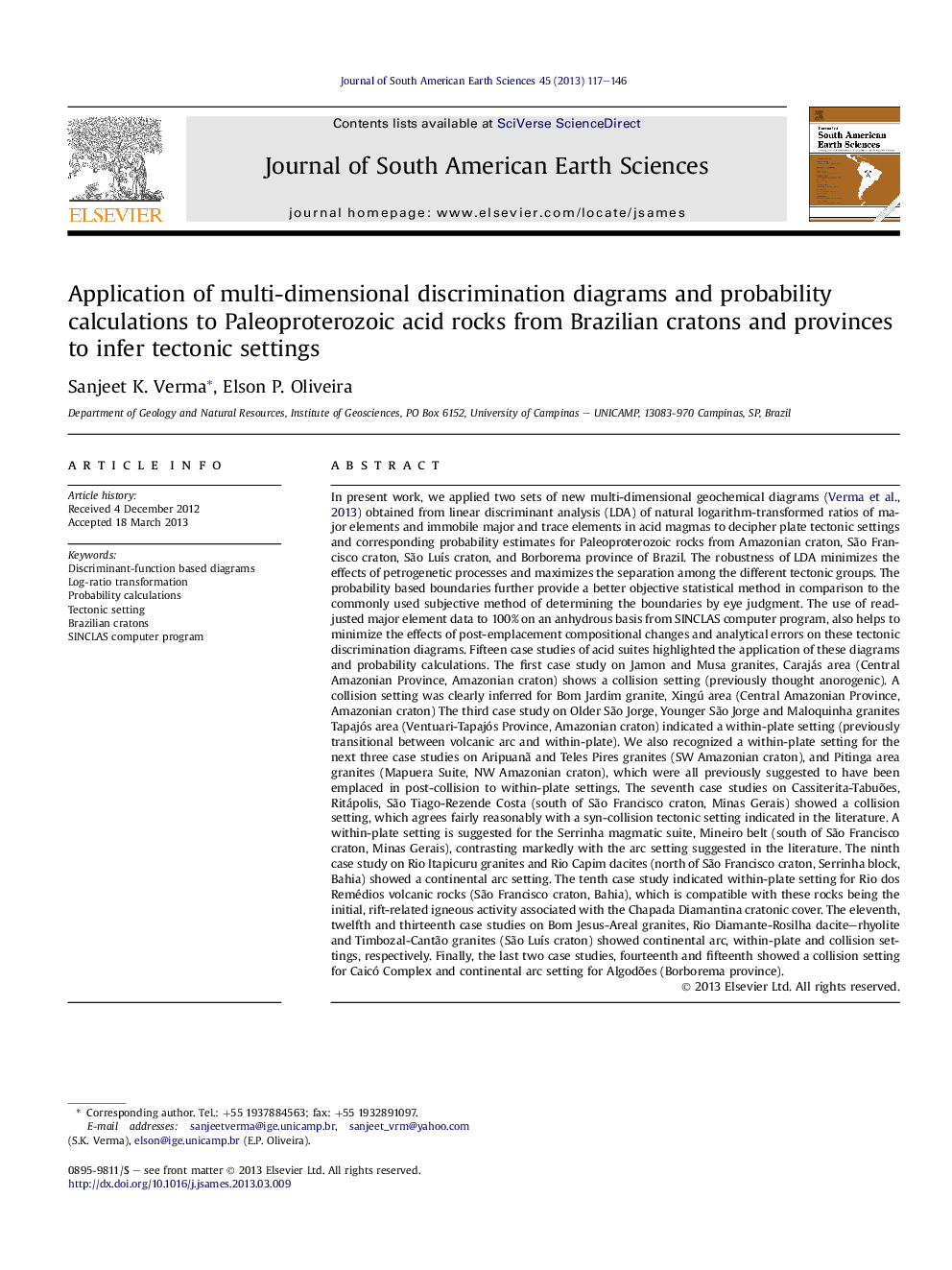| کد مقاله | کد نشریه | سال انتشار | مقاله انگلیسی | نسخه تمام متن |
|---|---|---|---|---|
| 4682338 | 1635164 | 2013 | 30 صفحه PDF | دانلود رایگان |
• Multi-dimensional geochemical diagrams were applied to infer tectonic settings.
• Paleoproterozoic acid igneous rocks of Brazilian cratons and provinces were studied.
• Tectonic settings were inferred: continental arc, within-plate, and collision.
In present work, we applied two sets of new multi-dimensional geochemical diagrams (Verma et al., 2013) obtained from linear discriminant analysis (LDA) of natural logarithm-transformed ratios of major elements and immobile major and trace elements in acid magmas to decipher plate tectonic settings and corresponding probability estimates for Paleoproterozoic rocks from Amazonian craton, São Francisco craton, São Luís craton, and Borborema province of Brazil. The robustness of LDA minimizes the effects of petrogenetic processes and maximizes the separation among the different tectonic groups. The probability based boundaries further provide a better objective statistical method in comparison to the commonly used subjective method of determining the boundaries by eye judgment. The use of readjusted major element data to 100% on an anhydrous basis from SINCLAS computer program, also helps to minimize the effects of post-emplacement compositional changes and analytical errors on these tectonic discrimination diagrams. Fifteen case studies of acid suites highlighted the application of these diagrams and probability calculations. The first case study on Jamon and Musa granites, Carajás area (Central Amazonian Province, Amazonian craton) shows a collision setting (previously thought anorogenic). A collision setting was clearly inferred for Bom Jardim granite, Xingú area (Central Amazonian Province, Amazonian craton) The third case study on Older São Jorge, Younger São Jorge and Maloquinha granites Tapajós area (Ventuari-Tapajós Province, Amazonian craton) indicated a within-plate setting (previously transitional between volcanic arc and within-plate). We also recognized a within-plate setting for the next three case studies on Aripuanã and Teles Pires granites (SW Amazonian craton), and Pitinga area granites (Mapuera Suite, NW Amazonian craton), which were all previously suggested to have been emplaced in post-collision to within-plate settings. The seventh case studies on Cassiterita-Tabuões, Ritápolis, São Tiago-Rezende Costa (south of São Francisco craton, Minas Gerais) showed a collision setting, which agrees fairly reasonably with a syn-collision tectonic setting indicated in the literature. A within-plate setting is suggested for the Serrinha magmatic suite, Mineiro belt (south of São Francisco craton, Minas Gerais), contrasting markedly with the arc setting suggested in the literature. The ninth case study on Rio Itapicuru granites and Rio Capim dacites (north of São Francisco craton, Serrinha block, Bahia) showed a continental arc setting. The tenth case study indicated within-plate setting for Rio dos Remédios volcanic rocks (São Francisco craton, Bahia), which is compatible with these rocks being the initial, rift-related igneous activity associated with the Chapada Diamantina cratonic cover. The eleventh, twelfth and thirteenth case studies on Bom Jesus-Areal granites, Rio Diamante-Rosilha dacite–rhyolite and Timbozal-Cantão granites (São Luís craton) showed continental arc, within-plate and collision settings, respectively. Finally, the last two case studies, fourteenth and fifteenth showed a collision setting for Caicó Complex and continental arc setting for Algodões (Borborema province).
Journal: Journal of South American Earth Sciences - Volume 45, August 2013, Pages 117–146
